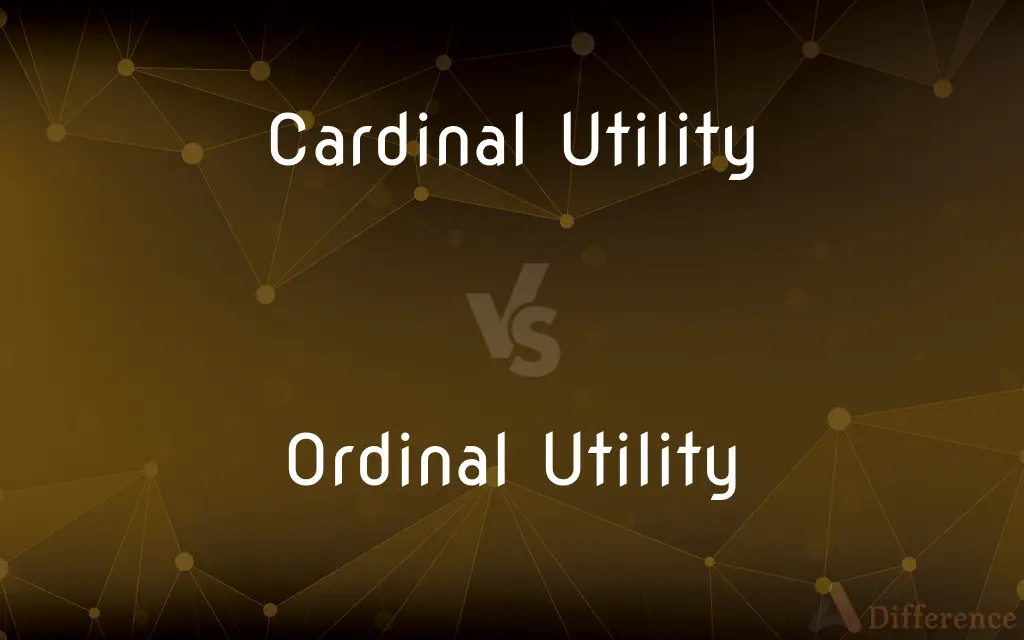Cardinal Utility vs. Ordinal Utility — What's the Difference?
By Tayyaba Rehman — Published on October 11, 2023
Cardinal Utility measures utility in quantitative units (utils), while Ordinal Utility ranks preferences without quantifying satisfaction.

Difference Between Cardinal Utility and Ordinal Utility
Table of Contents
ADVERTISEMENT
Key Differences
Cardinal Utility posits a perspective where consumer preferences and satisfaction can be measured in quantifiable units, often referred to as “utils.” On the flip side, Ordinal Utility adheres to a paradigm that insists on the ranking of preferences, wherein the satisfaction derived is organized in an order without an insistence on quantifying this satisfaction in measurable units.
In the scope of Cardinal Utility, the precise measurement or numerical quantification forms the crux, signifying that utility can be added, subtracted, or manipulated mathematically, thus facilitating a structured and calculative approach towards utility analysis. Contrastingly, Ordinal Utility adopts a more qualitative approach, relying heavily on the sequence or order of preference without delving into the mathematical nuances of consumer satisfaction, focusing more on the hierarchy of choices instead of their numerical significance.
Through the lens of Cardinal Utility, the measurable difference between two levels of satisfaction becomes paramount, effectively permitting the quantification of how much more one option is preferred over another. Alternatively, in the domain of Ordinal Utility, it is merely the order of preference that gains prominence, with explicit indifference towards measuring the exact magnitude of difference in utility between consecutively ranked choices.
Cardinal Utility provides a platform where differences in utility can be subjected to arithmetic operations, therefore offering an analytical portrayal of consumer choices and subsequent satisfaction, enabling a robust numerical understanding. Contrarily, Ordinal Utility offers an inherently simpler, yet potent, viewpoint, wherein preferences and choices are scrutinized through the prism of ranks and orders, sidestepping the potential complexities that may arise from a numerical analysis of consumer satisfaction.
Comparison Chart
Measurement
Quantitative (in utils)
Qualitative (ranks/preferences)
ADVERTISEMENT
Arithmetic Operations
Permissible
Not applicable
Measurement Precision
Exact units of satisfaction
Only preference order
Consumer Preference
Measured in absolute terms
Expressed through rankings
Analytical Approach
Mathematical
Non-mathematical
Compare with Definitions
Cardinal Utility
A numerical representation of satisfaction.
His cardinal utility scale designated 20 utils to enjoying a movie.
Ordinal Utility
A non-numerical representation of satisfaction.
Her ordinal utility for destinations placed Paris above New York.
Cardinal Utility
Satisfaction expressed in absolute numbers.
The cardinal utility assigned 15 utils to the perceived benefit of the product.
Ordinal Utility
Utility expressed through preference ranking.
Ice cream held a higher ordinal utility than cookies for John.
Cardinal Utility
Utility that allows for arithmetic operations.
Her cardinal utility derived from the jacket was calculated at 12 utils.
Ordinal Utility
Satisfaction represented by the order of choices.
For Jake, the ordinal utility ranked reading above hiking.
Cardinal Utility
Utility measured in quantifiable units.
The cardinal utility of the second apple was determined to be 10 utils.
Ordinal Utility
Utility that disallows quantitative operations.
In her ordinal utility list, jazz was preferred over pop, without numerical comparison.
Cardinal Utility
Quantitative analysis of consumer preference.
The cardinal utility of the meal was 30 utils, indicating high satisfaction.
Ordinal Utility
Qualitative assessment of consumer preference.
The ordinal utility of fruits ranked apples above oranges.
Common Curiosities
Does Ordinal Utility allow for quantitative comparisons?
No, Ordinal Utility only provides a ranking of preferences without quantification.
What is Cardinal Utility?
Cardinal Utility quantifies consumer satisfaction using measurable units known as utils.
Is Cardinal Utility qualitative or quantitative?
Cardinal Utility is quantitative as it assigns numerical values to utility.
How is Ordinal Utility expressed?
Ordinal Utility is expressed by ranking preferences without assigning numerical values.
Can Cardinal Utility be subjected to mathematical operations?
Yes, Cardinal Utility allows for mathematical operations due to its numerical nature.
Can ordinal preferences be measured in utils?
No, Ordinal Utility does not utilize utils and involves ranking without quantification.
What is a common unit used in Cardinal Utility?
Utils are commonly utilized as units in Cardinal Utility to measure satisfaction.
Why might economists prefer Ordinal Utility?
Economists might prefer Ordinal Utility for its simplicity and avoidance of utility quantification.
Share Your Discovery

Previous Comparison
Illiterate vs. Uneducated
Next Comparison
Impolite vs. PoliteAuthor Spotlight
Written by
Tayyaba RehmanTayyaba Rehman is a distinguished writer, currently serving as a primary contributor to askdifference.com. As a researcher in semantics and etymology, Tayyaba's passion for the complexity of languages and their distinctions has found a perfect home on the platform. Tayyaba delves into the intricacies of language, distinguishing between commonly confused words and phrases, thereby providing clarity for readers worldwide.















































